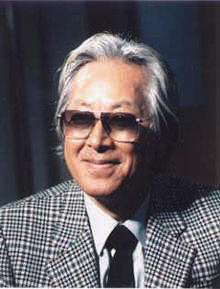
Back كينچى فوكاساكو ARZ Кинджи Фукасаку Bulgarian Kinji Fukasaku Catalan Kinji Fukasaku German Kinji Fukasaku Spanish کینجی فوکاساکو Persian Kinji Fukasaku Finnish Kinji Fukasaku French Kinji Fukasaku Galician Kinji Fukasaku ID
Kinji Fukasaku 深作 欣二 | |
|---|---|
 | |
| Born | 3 July 1930 Mito, Ibaraki, Japan |
| Died | 12 January 2003 (aged 72) Tokyo, Japan |
| Occupations |
|
| Years active | 1961–2003 |
| Title | President of the Directors Guild of Japan |
| Term | 1996–2003 |
| Predecessor | Nagisa Ōshima |
| Successor | Yoji Yamada |
| Spouse | Sanae Nakahara |
| Children | Kenta Fukasaku |
| Awards | Japan Academy Prize for Director of the Year 1982 Dotonbori River & Fall Guy 1987 House on Fire 1995 Crest of Betrayal |
Kinji Fukasaku (深作 欣二, Fukasaku Kinji, 3 July 1930 – 12 January 2003) was a Japanese film director and screenwriter. Known for his "broad range and innovative filmmaking",[1] Fukasaku worked in many different genres and styles, but was best known for his gritty yakuza films, typified by the Battles Without Honor and Humanity series (1973–1976). According to the Berkeley Art Museum and Pacific Film Archive, "his turbulent energy and at times extreme violence express a cynical critique of social conditions and genuine sympathy for those left out of Japan's postwar prosperity."[2] He used a cinema verite-inspired shaky camera technique in many of his films from the early 1970s.[3][4]
Fukasaku wrote and directed over 60 films between 1961 and 2003. Some Western sources have associated him with the Japanese New Wave movement of the '60s and '70s, but this belies his commercial success.[5][6] His works include the Japanese portion of the Hollywood war film Tora! Tora! Tora! (1970), jidaigeki such as Shogun's Samurai (1978), the space opera Message from Space (1978), the post-apocalyptic science fiction film Virus (1980), the fantasy film Samurai Reincarnation (1981), and the influential dystopian thriller Battle Royale (2000).
Fukasaku won the Japan Academy Film Prize for Director of the Year three times, out of nine total nominations. He served as President of the Directors Guild of Japan from 1996, until his death from prostate cancer in 2003. In 1997, he received the Purple Medal of Honor from the Japanese government for his work in film.[7] His films have inspired directors such as Quentin Tarantino,[8] William Friedkin,[9] and John Woo.[10]
- ^ Magnier, Mark (17 January 2001). "Looking Back at Work of Kinji Fukasaku, Beyond 'Green Slime'". Los Angeles Times. Archived from the original on 24 October 2022. Retrieved 6 October 2022.
- ^ "Kinji Fukasaku: Sympathy For The Underdog". BAMPFA. Archived from the original on 24 October 2022. Retrieved 6 October 2022.
- ^ Berra, John (2010). Directory of World Cinema: Japan (1st ed.). Bristol, UK: Intellect Books. p. 115. ISBN 978-1-84150-335-6.
- ^ Jane, Ian (30 January 2004). "Battle Royale II (Region 3)". DVD Talk. Retrieved 23 March 2012.
- ^ RetroRobin (25 June 2017). "The Japanese New Wave Film Rebellion". Into The Retroscope. Retrieved 6 October 2022.
- ^ "Kinji Fukasaku • Retrospective". Time Out Paris. Retrieved 30 April 2018.
His loose affiliation with the '60s New Wave of Japanese arthouse cinema belies Kinji Fukasaku's raw commercial appeal.
- ^ "Renowned director Fukasaku, of 'Battle Royale' fame, dies". The Japan Times. 13 January 2003. Retrieved 24 August 2014.
- ^ "Kinji Fukasaku • Retrospective". Time Out. 21 November 2016. Retrieved 23 March 2021.
- ^ "William Friedkin on Kinji Fukasaku". YouTube. Archived from the original on 12 December 2021. Retrieved 23 March 2021.
- ^ "Kinji Fukasaku -- director of graphic, provocative films". SFGATE. 28 January 2003. Retrieved 6 October 2022.
© MMXXIII Rich X Search. We shall prevail. All rights reserved. Rich X Search